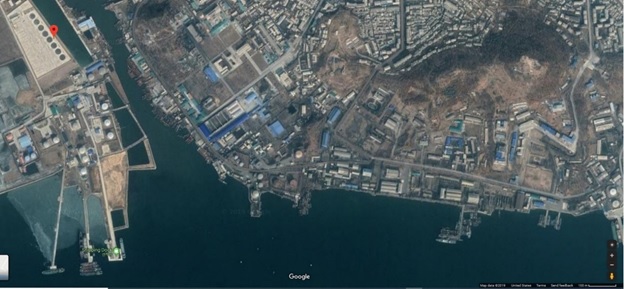DAVID VON HIPPEL, PETER HAYES, AND LIAM TASA
AUGUST 25, 2020
I. INTRODUCTION
In this Special Report, David von Hippel, Peter Hayes, and Liam Tasa describe an estimate of oil storage volumes in the Democratic People’s Republic of Korea. DPRK oil storage volumes are of interest to the international community for a number of reasons related to the DPRK’s energy sector and its connection with negotiations with the DPRK over its nuclear weapons program.
The full report in downloadable PDF format is found here. The Annex with full description of source material in downloadable PDF format is found here.
David von Hippel is a Nautilus Institute Senior Associate. Peter Hayes is Director of the Nautilus Institute and Honorary Professor at the Centre for International Security Studies at the University of Sydney. Liam Tasa is an independent analyst.
This report is published under a 4.0 International Creative Commons License the terms of which are found here.
Banner image: View of Tank Locations at Nampo Oil Storage Terminal (Google Maps image, 2019).
II. NAPSNET SPECIAL REPORT BY DAVID VON HIPPEL, PETER HAYES, LIAM TASA
ESTIMATE OF OIL STORAGE CAPACITY IN THE DEMOCRATIC PEOPLE’S REPUBLIC OF KOREA
AUGUST 25, 2020
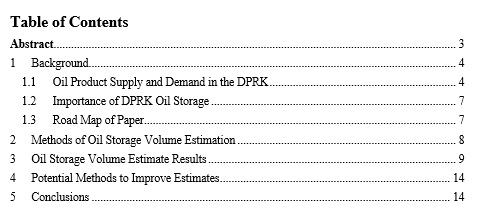
Summary
The volume of oil storage capacity in the Democratic People’s Republic of Korea (DPRK) is important for several reasons, including because it is a factor in the DPRK being more or less affected by international sanctions targeting its oil imports, in the DPRK’s ability to sustain a military conflict, and because the availability of oil storage may affect the logistics of providing humanitarian and economic development projects in different DPRK locations as engagement with the international community moves forward. In this Special Report we build upon a 1982 study to update an inventory of tanks likely used for oil storage in the DPRK. This update has used review of satellite images at locations identified in the 1982 study and elsewhere throughout the DPRK to assemble an estimate of the total oil storage volume that might be available and in usable condition in the DPRK. We estimate the volume of oil storage tanks to be on the order of 1.1 million cubic meters, with possibly several hundred thousand additional cubic meters of storage in underground bunkers that could not be evaluated from satellite images. This volume of storage corresponds to more than a year’s worth of recent annual DPRK oil products consumption, based on our estimates, but less than two years’ worth.
1. Background
The apparent success of United States President Donald Trump’s meeting with North Korean Chairman Kim Jong Un on June 30, 2019 in the Demilitarized Zone on the Korean Peninsula was expected, to lead to restarting talks between the Democratic People’s Republic of Korea (DPRK), the U.S., and others to work toward resolving issues related to the DPRK nuclear weapons and missile programs.[1] As of this writing, concrete plans for talks have not yet been announced, but appear to remain possible, despite aggressive rhetoric on both sides. If talks are restarted, topics related to the DPRK’s energy sector will likely be important, as the DPRK’s “energy insecurity”—including lack of stable, affordable, and clean energy supplies—is a key driver of its pursuit of a nuclear weapons (and weapons delivery) arsenal.[2] Energy topics included in talks between the DPRK and the U.S. and others will likely sooner or later include, for example, DPRK requests for relief of United Nations Security Council (UNSC) sanctions restricting the DPRK’s oil imports, and discussion of potential engagement projects targeted energy assistance for humanitarian purposes and for economic development. To that end, an understanding of the DPRK’s oil supply and demand situation is important in understanding both the effectiveness of sanctions and the end-uses that might be targeted by engagement projects and programs. The DPRK’s oil supply and demand situation in recent years has been the topic of a recent Nautilus Special Report by von Hippel and Hayes,[3] but one element of the DPRK’s oil supply infrastructure that has not, to our knowledge, been reviewed recently, at least in the public literature, is the volume of oil storage capacity available in the DPRK.
The analysis described in this Special Report, and detailed in a separate Annex volume to this Report, builds on and updates a 1982 assessment of the DPRK’s oil (meaning crude oil and oil products) storage capacity.
1.1 Oil Product Supply and Demand in the DPRK
The DPRK has limited, if any, domestic production of crude oil. As a consequence, oil to meet DPRK demand enters the country either as crude oil—almost entirely, at present, imported by pipeline from China—and as oil product imports. The crude oil imported from China is refined at the DPRK’s refinery at Sinuiju, the Pongwha Chemical Factory in the DPRK’s Northwest near the Chinese border. On the order of 500,000 to 650,000 tonnes of crude oil have been refined at Sinuiju annually in recent years. The oil products refined in-country are insufficient to meet demand in the DPRK, particularly in recent years as (for example) the North Korean transport sector has grown and an increasing number of diesel and gasoline generators have been imported to augment the country’s aging central grid system.[4] As a consequence, our estimate is that oil products imports, through both official (as reported in customs statistics) and unofficial channels, grew between 2010 and 2017, although UNSC sanctions have probably reduced overall imports since that time. Figure 1 shows our estimate of trends in DPRK domestic oil products production and imports of refined products by type into the DPRK from a variety of sources (but mostly China and Russia) from 1990 through 2017. Gasoline and diesel oil dominate imports and production, with heavy fuel oil production falling dramatically between 2016 and 2017 as a result of the addition of a fluid catalytic cracking unit at the Sinuiju refinery.
Figure 1:
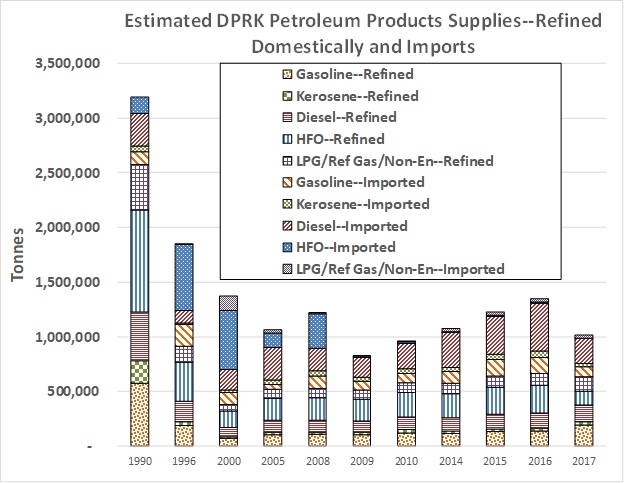 Estimated refined products demand in the DPRK as of 2017 by sector is presented in Figure 2. Here the transportation and military sectors dominate overall demand, with industry (mostly heavy fuel oil use) and the residential sector–mostly LPG (liquefied petroleum gas) and kerosene use—also accounting for significant shares. Note that the distinction between transportation and military fuel use is sometimes difficult to define in the DPRK, as military trucks can be used to transport soldiers and military goods, civilians, and non-military goods, often simultaneously. Figure 3 shows our estimated division between fuel types in DPRK petroleum products demand in 2017. Gasoline and diesel fuel, as the main fuels for the transport and military sectors, dominate the totals. Non-energy products in this figure include, for example, inputs to petrochemicals and fertilizer production, and asphalt for road construction. Not electricity generation is not included in these two figures, although the use of gasoline and especially diesel fuel for on-site generators has, by our estimate, risen dramatically in the DPRK through at least 2016.
Estimated refined products demand in the DPRK as of 2017 by sector is presented in Figure 2. Here the transportation and military sectors dominate overall demand, with industry (mostly heavy fuel oil use) and the residential sector–mostly LPG (liquefied petroleum gas) and kerosene use—also accounting for significant shares. Note that the distinction between transportation and military fuel use is sometimes difficult to define in the DPRK, as military trucks can be used to transport soldiers and military goods, civilians, and non-military goods, often simultaneously. Figure 3 shows our estimated division between fuel types in DPRK petroleum products demand in 2017. Gasoline and diesel fuel, as the main fuels for the transport and military sectors, dominate the totals. Non-energy products in this figure include, for example, inputs to petrochemicals and fertilizer production, and asphalt for road construction. Not electricity generation is not included in these two figures, although the use of gasoline and especially diesel fuel for on-site generators has, by our estimate, risen dramatically in the DPRK through at least 2016.
Figure 2:
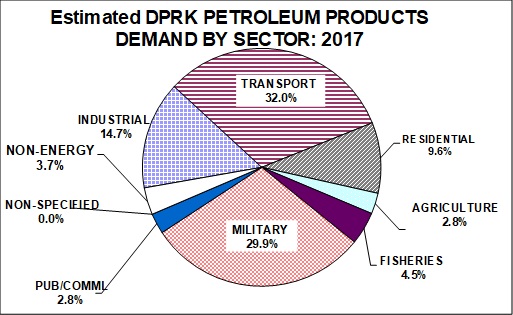
Figure 3:
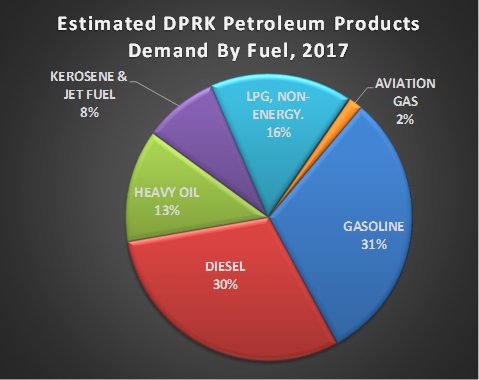
1.2 Importance of DPRK Oil Storage
The storage of crude oil and refined oil products—often in large above-ground cylindrical tanks, but sometimes in other types of tanks, in below-ground bunkers or even in natural underground caverns—occurs in probably every country on the globe. Oil storage allows refineries to accept large shipments of crude oil and use them over a period of days to months, allows refineries to build up stores of refined products for sale as needed, and allows refined products users and distributors to purchase large quantities of oil to be used or sold over time. Oil storage also allows countries, companies, or individual users to maintain supplies in case of a disruption in deliveries, whether caused by weather/natural disaster, conflict (including far away, such as in the volatile Middle East, or nearby), technical problems with oil production, refining or transport, oil price spikes, or other problems.
1.3 Road Map of Paper
In the remainder of this Special Report we:
- Summarize the methods of oil storage location and estimation used;
- Provide summary statistics of our oil storage estimates;
- Note potential methods for improvement on the estimates; and
- Offer conclusions as to the potential meaning of our estimates of DPRK oil storage volumes.
In addition, an Annex to this Special Report is provided as a separate report that provides:
- A summary of the oil storage estimate statistics compiled from our review and from the CIA document;
- Details of the Nautilus review of selected oil storage sites;
- Details of the Nautilus review of oil storage sites also included in the 1982 U.S. Central Intelligence Agency estimates;
- A summary of 1982 CIA Estimates of oil storage volumes by location that were not reviewed using Google Maps by Nautilus (including “Naval”, “Air”, and “Industrial”); and
- Details of the Nautilus review of possible oil storage sites not included in 1982 U.S. Central Intelligence Agency Estimates (those visible above-ground).
2 Methods of Oil Storage Volume Estimation
The Annex to the Nautilus Institute Special Report, Estimate of Oil Storage Capacity in the Democratic People’s Republic of Korea: Details of Estimates of Oil Storage Capacity by Location, provides details on many locations in the DPRK where oil storage (mostly refined oil products) have been found, have been reported in the past, or may be located. The Annex provides the results of an in-depth systematic review using Google Maps and Google Earth of locations in the DPRK. We have used as a starting point the following approach for map review:
- Review known oil storage locations, such as refineries and major terminals.
- Review oil storage locations provided in a redacted and publicly available 1982 report by the United States Central Intelligence Agency that identifies a large number of oil storage sites thought to be active as of the time of the report.[5]
- Review of Google Maps and Google Earth images along coastlines, rivers, railroads and major roads, looking for objects that might be oil tanks.
For potential oil storage locations identified as above, we counted the potential oil tanks present, estimated their diameters through measurements made using Google Maps tools, made estimates of tank heights based on the length of tank shadows as compared with those of nearby objects for which height can be roughly estimated, such as buildings, and noted the location (latitude and longitude), and captured images of tank locations.[6] We then used the diameter and (roughly estimated) height data to estimate the volume of the storage tanks. To try and estimate the probability that the tanks found were or are used for oil storage, we observed the proximity and condition of roads, railroads, ports, industrial facilities, and other infrastructure that might indicate active oil storage and use, as well as reviewing the apparent condition of the tanks themselves, and developed notes of observations about the tanks found. Those observations, in part, were used to prepare a subjective assessment as to the “fraction of volume estimated to be active oil storage” at each site. So, for example, if a tank were seen to be rusty, physically compromised, and/or located in an area that appeared largely abandoned, we would set the “fraction of volume estimated to be active oil storage” at zero (or low) whereas if the tank looked new, was in an area obviously under active use, and/or in an area known to be used for oil storage, we would be likely to provide a value of “fraction of volume estimated to be active oil storage” near 100%. Note that this factor is not intended to provide any indication of whether the tank is full, empty, or somewhere in between, as that status cannot reasonably be determined from satellite images (at least without other imaging data not available to us), rather it only provides an indication of whether the tank is in use.
Many of the sites reviewed in the 1982 US CIA document included tanks reported to be underground. In these cases, we reported what the CIA document reported, and reviewed the site to see if tanks were visible and/or the site looked active. We only counted tanks that we could see, so our accounting does not explicitly include those underground tank volumes identified by the CIA, but keeps those statistics in a separate category. It is essentially certain that the DPRK has ceased to use some of the underground tanks included in the 1982 CIA database (if indeed the assessments made at that time were accurate in all cases), and equally certain that the DPRK has developed (either before 1982 or since) additional underground storage that was and/or is not in the CIA database. To what extent these factors offset is impossible for us to say with the data we have at hand, all of which are derived from public sources.
3 Oil Storage Volume Estimate Results
The table that follows provides a summary of the volume of oil storage estimated in the groups of locations reviewed by Nautilus, together with the CIA estimates for locations with underground tanks that we could not see. Note that although these figures are provided, for convenience, to many significant figures, they should be considered accurate to at most about one significant figure, as they embody many measurement uncertainties.
In general, we found a total of about 1.1 million cubic meters (equivalent to on the order of 900,000 to 1,000,000 tonnes of oil product storage) of storage volume that we feel is likely to be active storage, not counting another 0.5 million cubic meters of storage reported by the CIA that we could not measure. Taken together, these data suggest that the DPRK’s oil storage facilities may be similar in volume to the total estimated by the CIA in 1982, about 1.6 million cubic meters. There is, however, substantial remaining uncertainty in these estimates due, first, to lack of knowledge about the status of those oil storage facilities identified by the CIA document as being underground, coupled with our lack of information on any underground storage developed by the DPRK that did not show up in the 1982 CIA database (because it wasn’t known about or reported, or had yet to be built), and second, due to uncertainties in the measurement, designation, and assessment of active storage in identified potential tanks.
SUMMARY OIL STORAGE STATISTICS FROM NAUTILUS REVIEW
| Groups of Locations Reviewed | Estimated Tank Volume, Cubic Meters |
| Total of volume of storage tanks measured at major sites and sites indicated by the CIA (including those measured that were included in the CIA database) | 1,111,638 |
| Total of volume of storage tanks measured as above (including those included in CIA database) and estimated to be likely to be currently used for oil storage | 1,006,665 |
| Total of volume of bunkers reported by CIA (1982) but not directly measured (excludes overlap with tanks directly measured) | 544,726 |
| Total of volume of all storage reported by CIA (1982), including “Naval”, “Air”, and “Industrial” | 1,648,847 |
| Total of volume of storage tanks measured by Nautilus (but not, to our knowledge, included in CIA database) | 285,499 |
| Total of volume of storage tanks measured by Nautilus (but not, to our knowledge, included in CIA database) and estimated to be likely to be currently used for oil storage | 109,227 |
Figure 4 and Figure 5 show respectively, as examples, the extensive storage facilities at the DPRK’s two major refineries, in the far Northwest (Ponghwa Chemical Factory near Sinuiju) and Northeast (the Seungri Chemical Complex refinery). Note that the latter includes a number of tanks that appear, from the degree of rust visible, to be disused. Figure 6 shows, again as an example, a much smaller storage installation: a set of what appear to be four oil tanks at a marina on the East coast of the DPRK near the city of Chongjin, apparently home to a local fishing fleet (the image was taken in the winter, and shows a number of fishing boats moored together at the dock). Figure 7 shows a number of tanks, some apparently relatively new, at and near the oil storage terminal at Nampo, the port city to Pyongyang. This terminal appears to include the footers for at least nine fairly large planned oil tanks, arrayed in a line near the river, and shows that construction of oil storage in the DPRK is ongoing.[7]
Figure 4: Oil Storage at the Ponghwa Chemical Factory
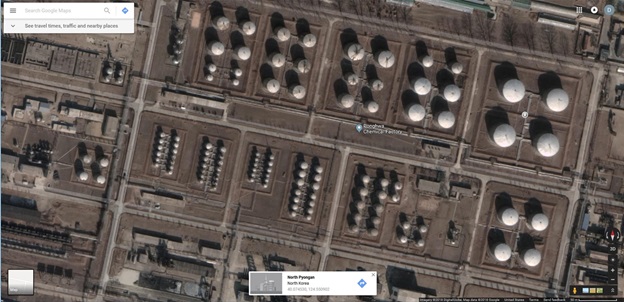
Figure 5: Two Views of Specific Tank Locations at the Seungri Chemical Complex
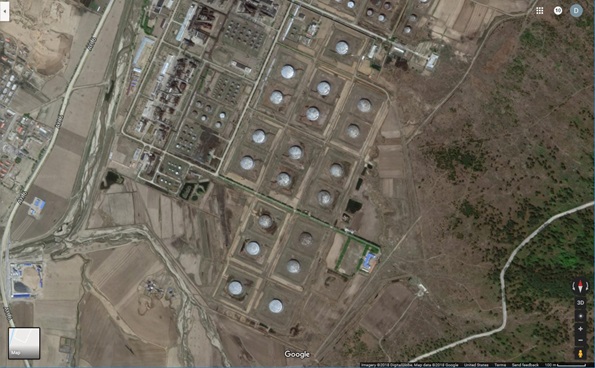
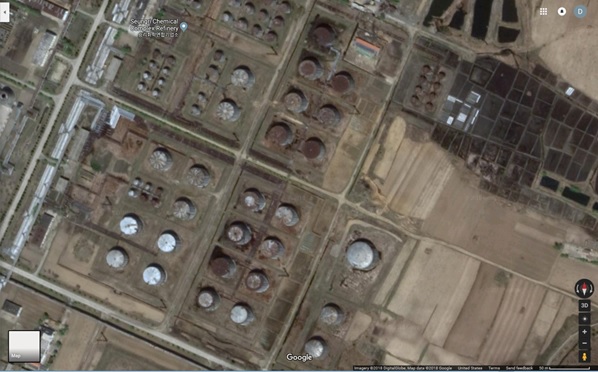
Figure 6: Oil Storage at a Marina near Chongjin
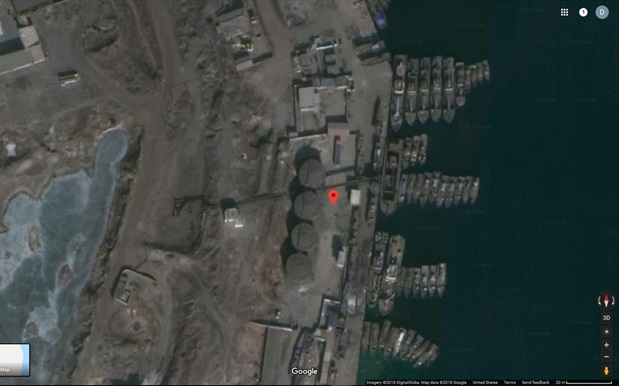
Figure 7: The Nampo Oil Storage Terminal
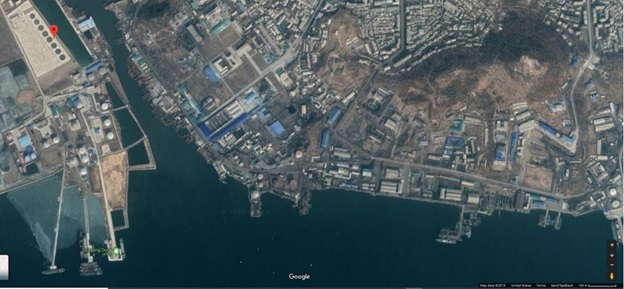
4 Potential Methods to Improve Estimates
The methods we have used in preparing the estimates above have been necessity quite basic. Access to more advanced image processing tools and techniques, as well as additional images, would make it possible to refine these estimates considerably. Among the possible options for improving estimates of oil storage capacity in the DPRK are:
- Having a time series of images to review, so that it is possible to see changes at each individual site over time.
- Having images that are time-stamped, and applying tools to estimate the angle of the sun at the time and location that the image was taken. These data should allow better estimates of the height of tanks, and thus of their volume.
- Having images that are of a higher resolution than the Google Maps/Google Earth photos available to us for this study. Higher-resolution images would allow a greater degree of certainty in, for example, identifying tanks that are disused, discerning oil tanks from other types of tanks, or looking for evidence of tanks that are buried in bunkers.
- Using computer-aided tools, such as Google Earth search scripts, to assist in making a more comprehensive search of images for objects that fit the description of oil tanks. Such searches would need to be reviewed to make sure that they did not include objects not likely to be oil tanks, or exclude objects that are oil tanks.
- Use of images that capture signatures other than visible light, for example, infra-red images, which might make it possible to determine whether oil tanks are full or not under certain ambient conditions. For example, we would expect a tank that was full of oil to heat up less than an empty one on a warm and sunny day, although experts in satellite imagery (which we are not) could doubtless bring more sophisticated tools to this evaluation.
- Having images reviewed by those more expert in oil storage so as be able to differentiate structures used for oil storage from those of similar shapes and sizes, such as tanks for water or tanks/silos used to hold other materials.
- And last but not least, ground truthing would help greatly to match estimates of volume and tank condition at particular locations to those of known tanks inspected in situ. This would ideally include review of tanks in the DPRK itself, although that is likely to happen at no more than a handful of locations, but might also include reviewing the situation in countries with tanks of similar construction to those found in the DPRK, including Russia and China.
5 Conclusions
The above estimates suggest that the DPRK has oil storage facilities that could accommodate on the order of 1 to 1.5 million tonnes of crude oil and (mostly) oil products. This would be the equivalent of about one year’s worth of our estimates of domestic oil products produced in the DPRK’s refineries plus our estimates of oil products imports in recent years combined. Again, it is impossible for us to know what fraction of these tanks are filled, and there are substantial uncertainties as to our estimates of tank volume and our designations of tanks as being actively used for oil storage.
Many of the tanks we found appear to have been built many years ago, but in several locations new tanks appear to have been built quite recently.
The volume of storage we have measured, however, plus the fact that we, like the CIA before us, have found what are apparently oil storage tanks in dozens of locations in the DPRK, suggest that even in the event of a total oil cut-off, meaning ceasing all imports of both crude oil and oil products, the DPRK would likely have the equivalent of many months of demand worth of oil products supplies in storage, and perhaps more, given that we were unable to assess the DPRK’s underground storage facilities. Note that a crude oil supply cut-off—meaning China ceasing to supply crude oil via the cross-border pipeline to the Sinuiju-area refinery—is unlikely, both for political reasons and for the technical reason that the viscous crude oil coming from China is reportedly prone to solidifying, particularly in wintertime, if flow is stopped, making re-starting flows very difficult. Similarly, short of an all-out blockade, which would require the active participation of the DPRK’s neighbors, cutting off all oil products imports, including unofficial imports, seems unlikely as well, given recent trends. The fact that oil products storage is found throughout the DPRK is not at all surprising, as distributed oil stores are found in nearly every country.
Our estimate—and it is of course just a rough estimate—of DPRK oil storage volumes is intended as an effort to help the international community to understand the DPRK’s energy supply and demand situation, which will be a crucial driver of the DPRK’s position in any upcoming talks on the DPRK’s nuclear weapons and related programs. As with many recent trends in the DPRK energy sector, the oil storage situation seems to indicate that resilience to energy supply disruptions both at a public (for example, national or local government development of oil storage) and an enterprise or personal level (purchase of diesel generators and solar photovoltaic panels) continues to be a significant focus in the DPRK. This focus should be seen as both an opportunity—as an indicator of underlying need—and a cautionary sign of DPRK resolve and flexibility to those who would engage the DPRK in talks on its weapons programs.
III. ENDNOTES
[1] See, for example, Yonette Joseph (2019), “4 Takeaways From the Trump-Kim Meeting at the DMZ”, The New York Times, dated June 30, 2019, and available as https://www.nytimes.com/2019/06/30/world/asia/trump-kim-north-korea-meeting.html.
[2] See, for example David von Hippel and Peter Hayes, “ENERGY INSECURITY IN THE DPRK: LINKAGES TO REGIONAL ENERGY SECURITY AND THE NUCLEAR WEAPONS ISSUE”, NAPSNet Special Reports, January 03, 2018, available as https://nautilus.org/napsnet/napsnet-special-reports/energy-insecurity-in-the-dprk-linkages-to-regional-energy-security-and-the-nuclear-weapons-issue/.
[3] David von Hippel, Peter Hayes, “ESTIMATES OF REFINED PRODUCT SUPPLY AND DEMAND IN THE DPRK, 2010 – 2017”, NAPSNet Special Reports, June 30, 2019, https://nautilus.org/napsnet/napsnet-special-reports/estimates-of-refined-prduct-supply-and-demand-in-the-dprk-2010-2017-2/. A revised version of this report taking into account a recent (approximately 2016) addition of a catalytic cracking unit at a DPRK refinery is forthcoming.
[4] See David von Hippel and Peter Hayes (2018), DPRK Motor Vehicle Imports from China, 2000 through 2017, and Implications for Changes in the DPRK Economy, Nautilus Institute Special Report dated August 23, 2018, and available as https://nautilus.org/napsnet/napsnet-special-reports/dprk-motor-vehicle-imports-from-china-2000-2017-implications-for-dprk-energy-economy/; and David von Hippel and Peter Hayes (2018), DPRK Imports of Generators in Recent Years: An Indication of Growing Consumer Choice and Influence on Energy Supply Decisions?, Nautilus Institute Special Report dated, November 02, 2018 and available as https://nautilus.org/napsnet/napsnet-special-reports/dprk-imports-of-generators-in-recent-years-an-indication-of-growing-consumer-choice-and-influence-on-energy-supply-decisions/.
[5] United States Central Intelligence Agency, National Photographic Interpretation Center (CIA, 1982), Imagery Analysis Report: POL Storage Capacity North Korea, 1982 Estimates. Report number CIA-RDP83T00574R000102600001-7 (redacted). Available as https://www.cia.gov/library/readingroom/docs/CIA-RDP83T00574R000102600001-7.pdf.
[6] In some cases these Google Earth images tell interesting stories of their own independent of oil storage findings, for example, about nearby industrial facilities, fishing fleets, or other facilities.
[7] All of the figures mentioned in this paragraph are from Google Maps, and likely dated from early to mid 2019.
IV. NAUTILUS INVITES YOUR RESPONSE
The Nautilus Asia Peace and Security Network invites your responses to this report. Please send responses to: nautilus@nautilus.org. Responses will be considered for redistribution to the network only if they include the author’s name, affiliation, and explicit consent.


